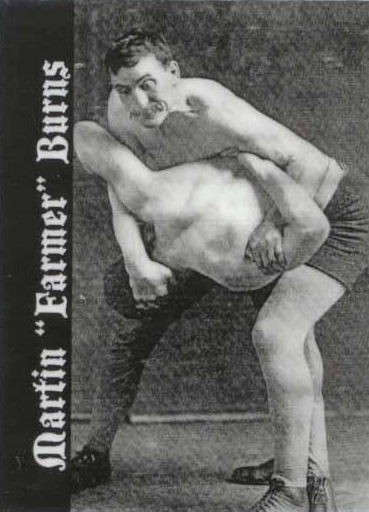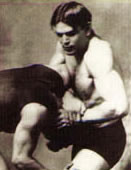HISTORY OF CATCH-AS-CATCH-CAN
Catch-as-catch-can wrestling (meaning catch any break you can to win) is a basic wrestling style in which nearly all holds and tactics are permitted in both upright and ground wrestling. Rules usually forbid actions that may injure an opponent, such as strangling, kicking, gouging, and hitting with a closed fist. The object is to force the opponent into a position in which both shoulders touch the ground at the same time. Formerly known as the Lancashire style in England, catch-as-catch-can became the most popular form of wrestling in Great Britain and the United States and, with slight modifications, was introduced into Olympic and international competition as freestyle wrestling.
 |
| Martin "Farmer" Burns |
While some speculate that it began in Ireland, the exact beginnings of catch-as-catch-can wrestling are not known. The first recorded matches contested under its rules (i.e., submission or pin wins the match, best two of three falls, no points, and win, lose, or draw format) began appearing in Lancashire, England.
The men were tough and often wrestled each other for personal enjoyment—bets were made after a long day spent in the coalmines. Eventually some of these men earned enough money from these bets to make a living and from this modern professional wrestler was born.
 |
| Hammerlock |
The game of catch-as-catch-can was growing in popularity and it followed immigrants from England and Western Europe to the United States of America. A true workman's sport that required little, if no, expensive equipment, catch wrestling spread quickly among bored soldiers during the American Civil War.
By the end of the 19th century, Americans were so enamored with catch-ascatch- can that contests attracted paying crowds and championships were held. With championships and paying crowds came the first wrestling celebrities.
Predictably, aggressive and ambitious men from all across the land would travel hundreds of miles to take up the challenge carnival wrestlers provided. Naturally, these challengers went to great lengths to achieve victory, so wrestlers had to prepare for anything a local could dream up. Since submissions ended a fight quickly and convincingly, the carnies became very adept at them. Catch wrestlers were aggressive, and the casual onlooker might have mistaken them for being unrefined and primitive. Catch wrestling historian and practitioner Kris Latskevich disagrees, stating "The system is based on domination and pain compliance, but also on leverage, physics, and control. The use of pressure points also encouraged set up techniques and kept opponents on the defensive. Catch wrestling has a wide appreciation of body mechanics and demonstrates a flexible and innovative mindset when it comes to submissions. Not only does it use the typical submissions you see across styles, but also flows freely from one technique to another, often times improvising submissions to better take advantage of whatever the opponent leaves open during a scramble. Hence, the name catch-as-catchcan wrestling."
The first big celebrity in America was Evan "The Strangler" Lewis (not to be confused with the later champion, Ed "Strangler" Lewis). He was notorious for attempting to use illegal choke holds to win his matches.
The popularity of catch wrestling grew; drawing millions of dollars, but unfortunately, with the money came corruption. Greed led promoters and competitors to fix fights. This ultimately led to a crisis of confidence and professional wrestling ceased to be a professional sport and became entertainment art.
 |
| Catch wrestling luminary, Frank Gotch |
While in the United States in 1913 and 1914, Gustav Fristensky had to defeat 60 catch-as-catch-can wrestlers in order to deserve the right to challenge the reining world champion Frank Gotch. Gustav won 59 bouts and then lost to Charles Cutler in Chicago, thus never having the opportunity to go up against Gotch.
Bibliography
http://www.catchwrestle.mobi/app/evolution-of-catch-wrestling/84545/36/
http://www.fightmagazine.com/mma-magazine/mma-article.asp?aid=465&issid=33

